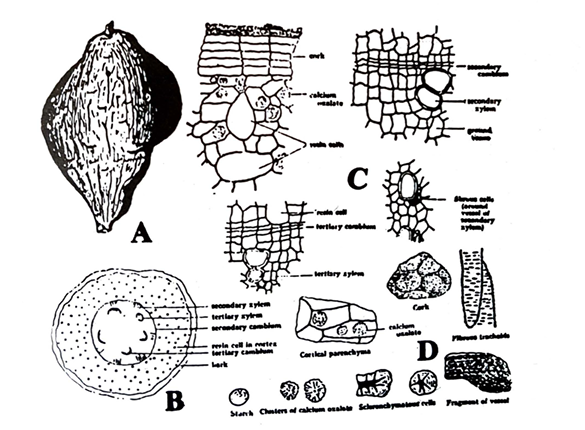Synonyms:
Jalapa, Jalapae Radix
Botanical source:
Jalap consists of the dried tubercules of Ipomoea purga Hayne, a climbing, twining plant of the family Convolvulaceae.
Geographical source:
The plant is indigenous to Mexico and cultivated in India from where most of the commercial supply comes.
Macroscopical characters:
The tubercules are irregularly oblong, cylindrical, napiform or fusiform in shape, 3 to 15 cm long and 3 to 8 cm in diameter. The surface is longitudinally wrinkled with transverse lenticels and dark brown in colour. The transversely cut surface shows narrow cork, a narrow band of phloem, a circular cambium, arcs of tertiary cambium towards the centre and numerous resin cells. It has a smoky odour and a sweetish acrid taste.

Fig. 58: Jalap. A, whole drug; B, transversely cut surface; C, tissues in transverse section; D, cell elements and cell contents in powder. (Reconstructed from Hebert & Ellery)
Microscopical characters:
The cork consists of several layers of thin-walled tangentially elongated cells. The cortical parenchymatous cells contain simple and compound starch grains and cluster crystals of calcium oxalate. Numerous resin cells containing a yellowish brown resin occur in the cortex. The ground tissue contains very wide medullary rays and the central tissue consists mainly of parenchymatous cells containg starch and resin. Vessels of secondary xylem have numerous bordered pits.
Chemical constituents:
Jalap principally contains a glycosidal resin (8 to 20 percent). Other constituents include mannitol, sugars, starch, Beta-methyl aesculetin and calcium oxalate.
Uses:
Jalap is used as a hydragogue cathartic. In smaller doses it acts as a laxative and in larger doses it causes active purgation.
Substitutes and adulterants:
The dried tubercules of Ipomoea simulans (Tampico Jalap), Ipomoea orizabensis (Orizaba Jalap) and also Mirabilis jalapa (Family Nyctaginaceae) have been frequently used as substitutes and adulterants of Jalap.

